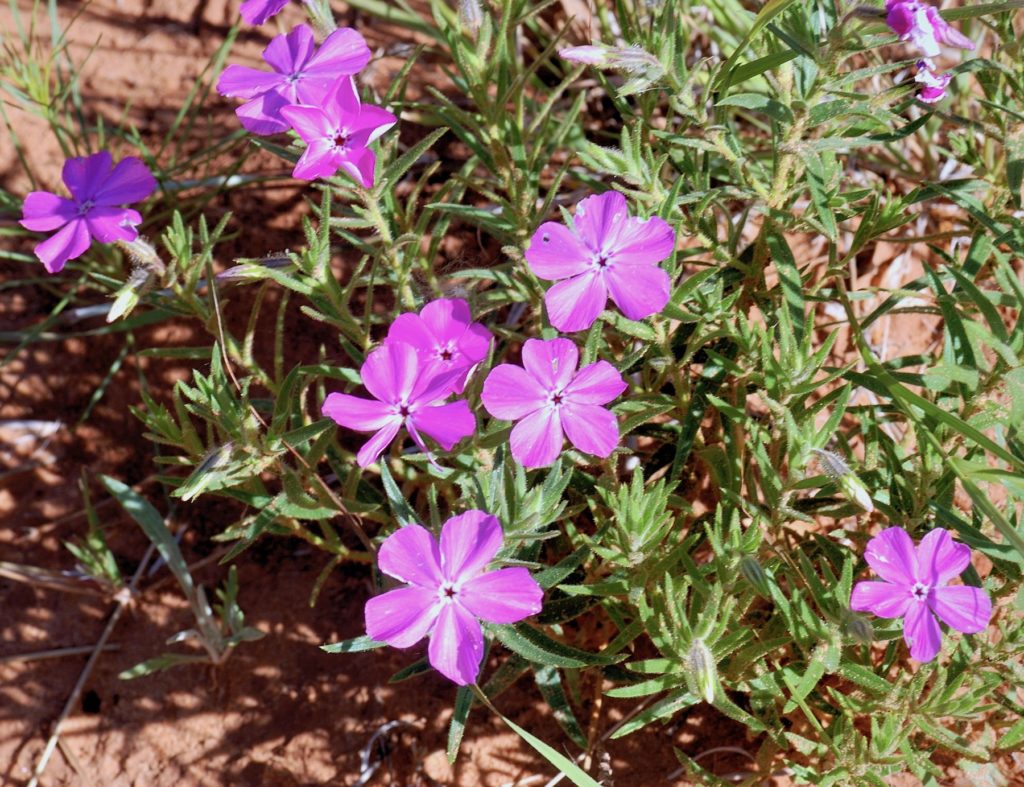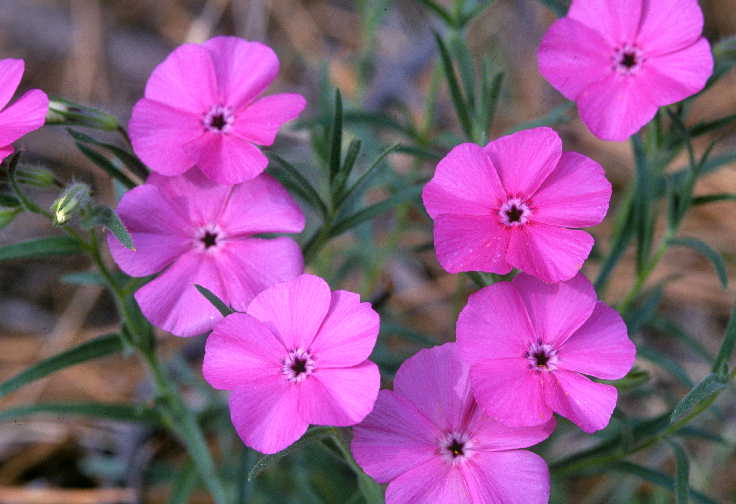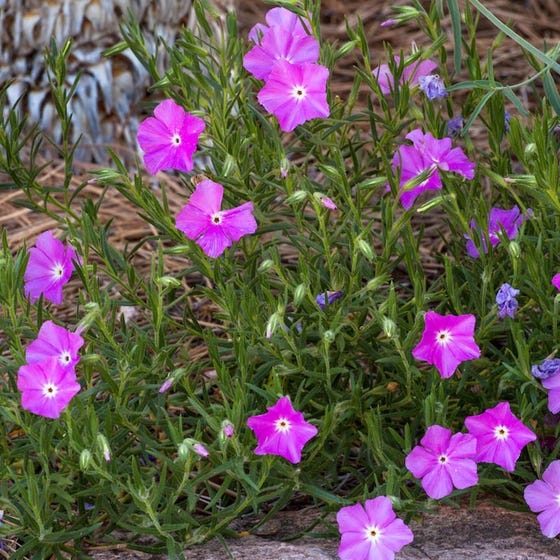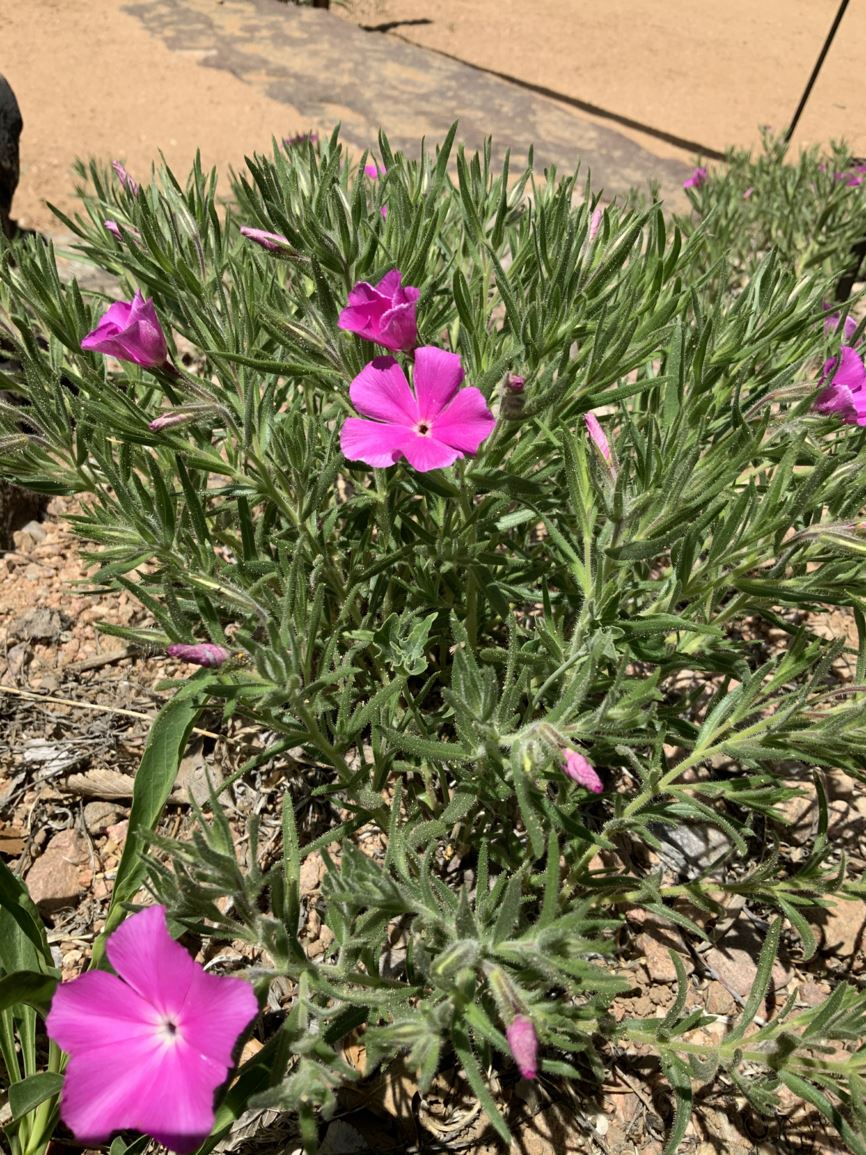Scientific Names: Phlox nana Nutt. and Phlox nana ‘Perfect Pink’
Suggested pronunciation: floks NAN-uh
Common names: Santa Fe phlox, white-eyed phlox, canyon phlox, Santa Fe phlox ‘Perfect Pink’
Family: Polemoniaceae (phlox)
Suggested pronunciation: po-le-moh-nee-AY-see-ee
Article by Janice Tucker
Several years ago I joined a small group of plant lovers on a day trip to a place known as “Cactus Hill”, located on Forest Service land near the tiny, unincorporated village of Bernal, New Mexico. It was June, which is usually the month that cacti come into full bloom. Upon arrival we were delighted to find both the hill and an open meadow across the road covered with a variety of blooming cacti as well as an abundance of wildflowers. We carefully picked our way through the thorny cacti as well as the “presents” that open-range cattle had left behind. I paused to take photos of several flowers, many of them new to me. Satisfied with the pictures, I lowered the camera and raised my eyes to find myself face-to-face with a small, lovely plant with brilliant pink flowers, later identified to me as Santa Fe phlox (Phlox nana). I was smitten! To quote George Miller, botanist, photojournalist past Albuquerque Native Plant Society president, botanist and photojournalist, “…the biggest thrill is always the one-on-one encounter with a wildflower in all its glory – and its mystery”. Indeed, the Santa Fe phlox was in its glory – small in stature and big in flowers. As for the mystery, every plant holds secrets just waiting to be discovered.

Phlox nana (Santa Fe phlox) in natural habitat at Cactus Hill. Photo by Janice Tucker.
The rather narrow native range of Santa Fe phlox is located in New Mexico and Texas. However, it has spread to adjoining areas where growing conditions meet its requirements. It was probably given the common name, Santa Fe phlox, because of its native status in the southwestern United States. While there are other common names, we Santa Feans prefer the vernacular, Santa Fe phlox, and intend to keep it that way.
It thrives on mesas, in rocky dry slopes, along roadsides and in canyons in elevations of 3,600-5,100 feet. However, it seems to do just fine at Santa Fe’s higher altitude of 7,198 feet. Drought tolerant and hardy in USDA Zones 4 to 8, the perennial Santa Fe phlox has proven its mettle as a wildflower that easily withstands cold winters and hot, dry summers as well as high winds and dramatic temperature swings.
Hairy stems, covered with equally hairy, linear leaves, branch out from a deep taproot to form a low-growing mound no more than 12” in height with a spread of 12” to 15”. The long taproot absorbs water which helps aid survival during hot, dry conditions. The hairy foliage traps moisture that provides extra protection against drought. Brilliant- almost luminous-five petaled flowers that surround a star-shaped center outlined in white are borne at the terminal end of the stems. The petals are normally in hues of dazzling pink, and rarely white or yellow. But whatever the color, those flowers are bright.
Seed propagation occurs when the seeds are ripe for germination. The seeds do not fall to the ground. There are no tufts attached that would allow them to be carried away by the wind. Instead they explode. When the time is ripe, they literally erupt very quickly from the seedpods. Where they land, is anyone’s guess. Plants have a strong determination for survival and often have more than one method to ensure their existence. Therefore, the Santa Fe phlox also propagates by sending out horizontal stems (stolons) that extend out from the taproot. These stolons take root to develop new plants that promote their spread. Those methods are nature’s way to propagate this plant. The propagation practice is a bit different when it comes to producing the Santa Fe phlox in large quantities for commercial nurseries.
Seed collection is impractical and basically impossible for nurseries – or for anyone else. There seems to be no rhyme or reason to determine when the seeds will be ripe enough to pop out of the seedpods. Combining that with the distance the seeds travel from the plant, trying to collect them is not feasible for commercial nurseries. For years the nurseries would seek out the Santa Fe phlox in its native habitats so they could dig up stolons and try rooting them in their greenhouses. But this method fell short of producing large enough amounts to supply demand. This was frustrating to plant professionals. Here was an attractive, native plant that was easy to grow once established, but difficult to propagate in large quantities.

Phlox nana by Bob Sivinski, SEINet Arizona New Mexico Chapter.
Horticulturists are persistent souls, and we gardeners owe them our gratitude for that trait. One such well-known and highly respected horticulturist is David Salman, founder and chief horticulturist at both the mail-order nursery, High Country Gardens, and the retail nursery, Waterwise Gardening in Santa Fe, New Mexico. David recounts his up and down….and up again experience in propagating the Santa Fe Phlox. For years David collected rooted stolons from roadside habitats. He would dig the stolons when the soil was soft and wet. The best time to do that was in July and August when the monsoon seasons provided good rains (or as he says, the way they used to do). He was not able grow as many plants as he wished using this method. But each year he did manage to harvest and then root the cuttings. But the amounts he needed to take root still eluded him. During August about 10 or 12 years ago David’s persistence was rewarded. A large number of cuttings took root. Since then he has been satisfied with the amount of subsequent cuttings that have taken root. He gave the selection the cultivar name of ‘Perfect Pink’. The flowers have overlapping petals that emit a pleasant fragrance in the morning, which dissipates before mid-day. Since propagating the Santa Fe phlox ‘Perfect Pink’ (Phlox nana ‘Perfect Pink’), he has not collected other Phlox nana plants for rooting.
David’s success with root propagation of the Santa Fe phlox ‘Perfect Pink’ has been lauded and cheered by the plant community, and deservedly so. Denver Botanic Garden director of outreach, Panayoti Kaleidis declares that this plant should be in everyone’s xeriscape or rock garden and asserts, “Kudos to High Country Gardens for cracking the code of how to grow this plant!”

Phlox nana ‘Perfect Pink’ David Salman © waterwisegardening.com
These special jewels can be seen in the Santa Fe Botanical Garden at Museum Hill in Santa Fe, New Mexico. They are located in the Pavilion Planting Area center steps bed, east bed and west bed. The head gardener, Linda Churchill, says this about the Santa Fe phlox ‘Perfect Pink’: “I would say, we (at SFBG) have tried it in several locations around the Bridge Approach with and without drip irrigation, but all with gravel–not organic–mulch and it has thrived. It has an exceptionally long bloom time and has required absolutely no care by the gardeners. It has re-seeded gently in the general areas where it was originally planted, but has not become an aggressive problem in any of our beds. And that particular color of —how would you describe it, electric pale lavender/magenta?, not just pink–nearly glows in the twilight when I’m working late. Definitely a 5-star plant for Santa Fe water-thrifty gardens!”

Santa Fe phlox at Santa Fe Botanical Garden Museum Hill. Photo by Cristina Salvador.
The Phlox nana ‘Perfect Pink’ may be diminutive but has a large presence in the landscape. The bright flowers bloom from late spring to early summer and sometimes extend into early fall depending on the weather. It adds splashes of color in xeric gardens, accents rock gardens and defines edges of flowerbeds and pathways. Use it as a ground cover or in mass plantings to make a dramatic floral statement. In either spring, summer or fall, find a spot in full sun and be sure to use only soil that drains well. Once the roots are established there is usually no need for supplemental water. It is very attractive but not fussy about maintenance and says, “no thanks” to fertilizer. The native, drought-tolerant Santa Fe phlox is easy to grow in our challenging climate, which makes it a good choice for private outdoor spaces. It is a magnet for butterflies, moths, bees and hummingbirds and seems to have little attraction to rabbits.
The esteemed English botanist and zoologist, Thomas Nuttall (1786-1859), spent 33 years (1808-1841) working in America, which is where he came across the plant he would name Phlox nana. The generic, Phlox, means “flame or blaze” and the specific, nana, describes its small size. “Small flame.” One wonders if Mr. Nuttall recognized the poetic nuance of the definition. It is truly an apt description for this low-growing plant with showy, brilliant flowers. Whether in the wild or in carefully landscaped gardens, may their small flames continue to radiate wherever they reside.
Many thanks to Helen Woody and Jeanne Gozigian for proofreading this article.
Writers note: Much appreciation goes out to David Salman, chief horticulturist and founder of High Country Gardens and Waterwise Gardening for taking his time to relay his experience in propagating the Phlox nana. The sharing of his knowledge was most valuable in writing this article.
And many thanks to Linda Churchill, Santa Fe Botanical Garden’s head gardener, for her assessment of the Santa Fe phlox. Her comments will appeal to all gardeners who want to know more about how this special plant behaves in the garden. To David and Linda, thank you.
Sources Consulted and/or cited:
Note: Janice featured the Santa Fe phlox (Phlox nana) as the August 2011 Plant of the Month. Since then, important information has been developed regarding this plant. The August 2011 article is listed below in the sources.
Hirons, Janet. Santa Fe Phlox (Phlox nana. Santa Fe Extension Master Gardeners. Web. 30 May 2109. 11 Feb 2021. Retrieved from: https://www.sfemg.org/2020-blog/santa-fe-phlox-phlox-nana.
Miller, George. Wildflower Heaven. New Mexico Magazine. Web. Mar. 2020. 19 Feb 2021. Retrieved from: https://www.newmexico.org/nmmagazine/articles/post/new-mexico-wildflowers/.
“Phlox nana”. Garden Explorer. Santa Fe Botanical Garden. Web. 10 Feb 2021. 11 Feb 2021. Retrieved from: https://santafebotanicalgarden.gardenexplorer.org/taxon-763.aspx.
“Phlox nana” Plant Database. Lady Bird Johnson Wildflower Center. Web. 23 Jan 2011. 11 Feb 2021. Retrieved from: https://www.wildflower.org/plants/result.php?id_plant=PHNA2.
“Phlox nana Nutt.” SEINet. http//:swbiodiversity.org/index.php. Web. Accessed on February 11, 2021. Retrieved from: https://swbiodiversity.org/seinet/taxa/index.php?taxon=Phlox+nana&formsubmit=Search+Terms.
“Phlox nana (Santa Fe phlox)”. USDA, NRCS. 2021. The PLANTS Database (http://plants.usda.gov, 11 February 2021). National Plant Data Team, Greensboro, NC 27401-4901 USA.
“Santa Fe Phlox ‘Perfect Pink’ “. High Country Gardens.Web. 2019. 11 Feb 2021. Retrieved from: https://www.highcountrygardens.com/perennial-plants/phlox/phlox-nana-perfect-pink.
Schneider, Al. Biographies of scientists and explorers honored in names of plants – Page 3 of 3. Thomas Nuttall. Southwest Colorado Wildflowers. Web. 2021. 18 Feb 2021. Retrieved from: https://www.swcoloradowildflowers.com/biographies%20of%20naturalists%203.htm.
Tucker, Janice. “Phlox nana”. August 2011 Plant of the Month. Santa Fe Botanical Garden. Web. 2020. 19 Feb 2021. https://visitsfbg.org/august-2011/.


